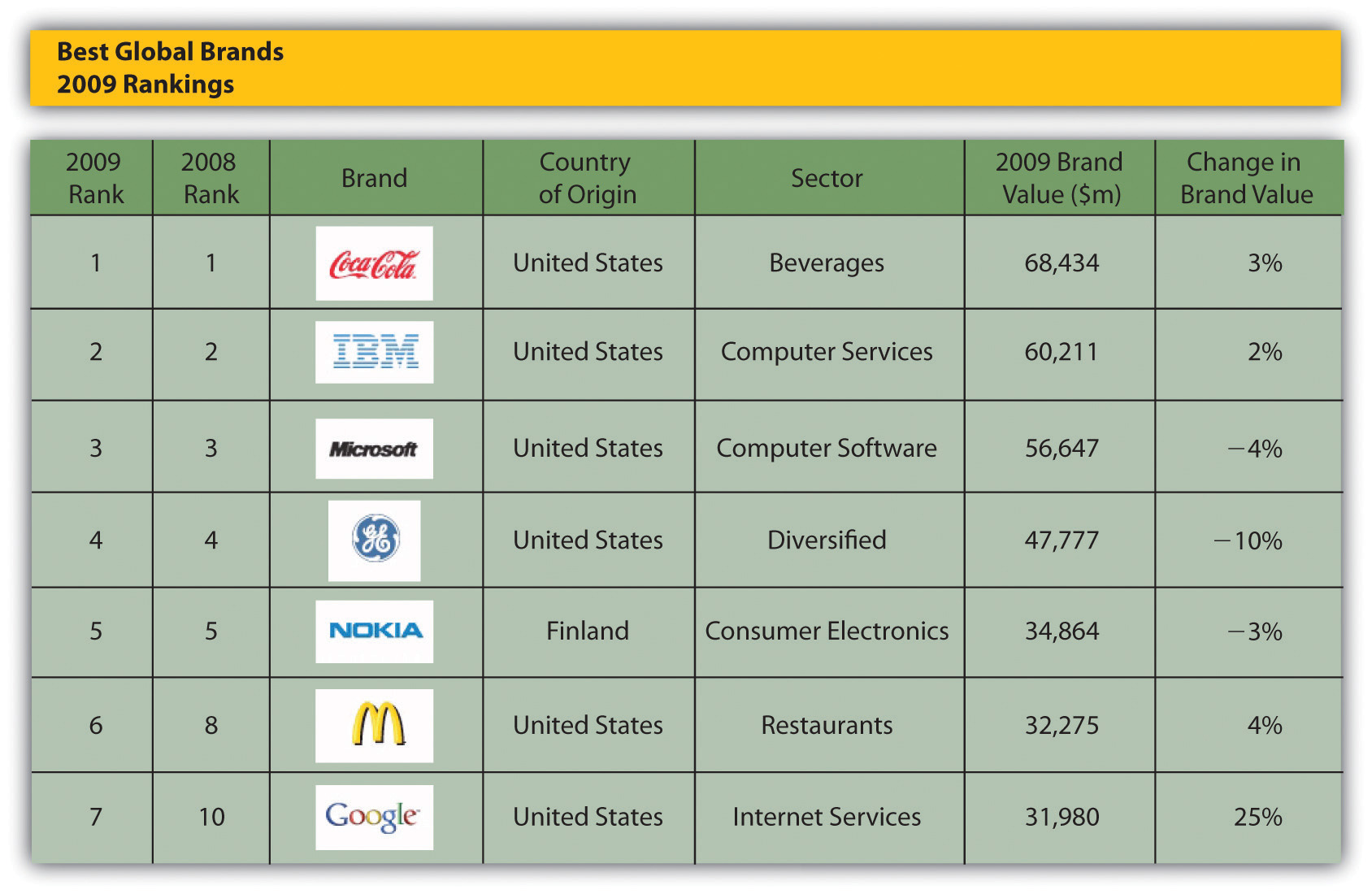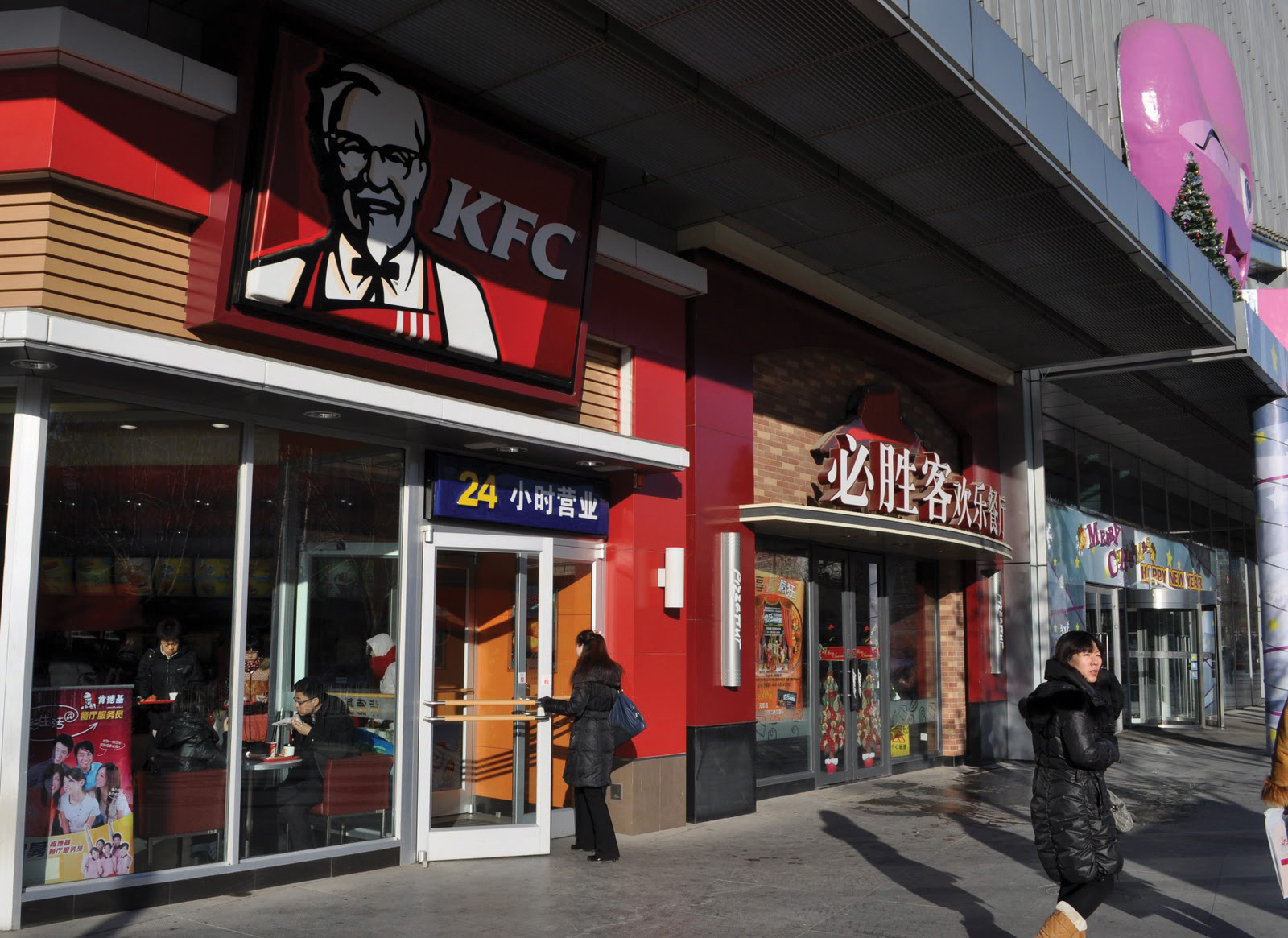This is “Competing Effectively through Global Marketing, Distribution, and Supply-Chain Management”, chapter 14 from the book Challenges and Opportunities in International Business (v. 1.0). For details on it (including licensing), click here.
For more information on the source of this book, or why it is available for free, please see the project's home page. You can browse or download additional books there. To download a .zip file containing this book to use offline, simply click here.
Chapter 14 Competing Effectively through Global Marketing, Distribution, and Supply-Chain Management

Source: Interbrand
What’s in It for Me?
- What are the fundamentals of global marketing?
- What are the trade-offs between standardized and customized products and promotions?
- What are the fundamentals of distribution?
- How does international distribution differ from purely domestic distribution?
- What are the international aspects of supply-chain management?
In this chapter, you’ll learn the “hows” of global marketing, distribution, and supply-chain management. Specifically, you’ll see how companies decide which products to market internationally, how to source and distribute those products, and how to manage operations for smooth operation throughout the company’s supply chain.
The chapter opens with a case study on Yum! Brands’ entry into China with KFC restaurants. After initial missteps, Yum! Brands and KFC have had great success and are now pondering ways to sustain that success. In Section 14.1 "Fundamentals of Global Marketing", you’ll learn the fundamentals of marketing in an international context. If the world were truly flat, then it would be easy to sell a product or service that is popular in one setting in another country setting with little additional work. However, because the world is not truly flat in terms of culture, administration, geography, and economics (i.e., CAGE), firms must make choices as to how they adapt to or avoid international markets. You’ll see how companies like Starbucks adapt and innovate in different markets, how integrated-circuit maker Intel deals with the difficulties of counterfeit markets, and how entertainment giant Bertelsmann makes decisions in emerging markets. You’ll also get a glimpse of how consumers in BRIC countries (i.e., Brazil, Russia, India, and China) differ and the special challenges of marketing products to countries where incomes are low.
You’ll be following along as companies like Nokia make decisions about whether to adapt products to specific markets. You’ll see the innovations that Procter & Gamble and General Electric create as they develop products for BRIC countries and how these innovations earn them additional benefits back home in developed markets. You’ll learn how to avoid the pitfalls that trapped Ford Motor Company, and you’ll see the entrepreneurial approaches to distribution management that Unilever created. Section 14.4 "Global Sourcing and Distribution" will highlight the difference between outsourcing and offshoring and the advantages and disadvantages they bring. Finally, Section 14.5 "Global Production and Supply-Chain Management" will demonstrate the value of an integrated approach to supply-chain management.
Opening Case: Colonel Sanders Is No Chicken!
Kentucky Fried Chicken (KFC) was the first American fast-food restaurant to enter China, opening its first outline there in 1987 in Beijing.The Gale Group Inc., “KFC Corporation,” International Directory of Company Histories, accessed December 19, 2010, http://www.answers.com/topic/kfc-corporation. KFC’s US archrival, McDonald’s, didn’t open a restaurant in China until 1990.Jennifer Lawinski, “KFC, Taco Bell a Hit for YUM! in China,” Slashfood, July 15, 2010, accessed December 14, 2010, http://www.slashfood.com/2010/07/15/kfc-taco-bell-a-hit-for-yum-in-china/#ixzz16JzYnIBS. Despite initial marketing mistakes—like its “finger lickin’ good” slogan being mistranslated into Chinese characters that meant “eat your fingers off”—the company grew and thrived.Carlye Adler, “Colonel Sanders’ March on China,” Time, November 17, 2003, accessed December 14, 2010, http://www.time.com/time/magazine/article/0,9171,543845,00.html. Today, KFC has 2,872 restaurants in China, which generate over $2 billion in sales for its parent company, Yum! Brands.“Restaurant Counts: 2009 Q4 Restaurant Units Activity Summary,” Yum! Brands, accessed December 14, 2010, http://www.yum.com/investors/restcounts.asp.

KFC is gaining popularity in the large Chinese market.
Source:© Yum! Brands
The main factor contributing to KFC’s success in China is its localization strategy. Let’s see how KFC did it.
When KFC first entered the Chinese market, Chinese law stipulated that foreign companies could only operate in China if they had a local partner. KFC selected partners who had connections to government, so that it could benefit from their resources and contacts.Karen Cho, “KFC China’s Recipe for Success,” INSEAD, July 1, 2009, accessed December 14, 2010, http://knowledge.insead.edu/KFCinChina090323.cfm?vid=195. KFC learned a lot from its local partners, and once joint ventures were no longer required, KFC chose a leadership team that knew Chinese culture intimately. Rather than sending expatriates to China to lead the expansion, for example, KFC selected people who had “an understanding of China and the Chinese cultural context ‘so deep that it is intuitive,’ to understand the Chinese people’s ‘mixed feelings, of love and hate about the West, to understand Chinese history, language, the influence of Confucianism, Buddhism and Taoism, this is especially important if you are in the consumer goods industry,’” said Warren Liu, former vice president of development at KFC China and author of the book KFC in China: Secret Recipe for Success.John Sexton, “KFC—‘A Foreign Brand with Chinese Characteristics,’” China.org.cn, September 22, 2008, accessed December 14, 2010, http://www.china.org.cn/business/2008-09/22/content_16515747.htm. This leadership team recommended that KFC follow a strategy of localization: offering local Chinese food options on the menu to appeal to local tastes. For example, instead of serving coleslaw, KFC offers bamboo shoots and lotus roots. Likewise, it sells a sandwich in the style that Peking duck is served, simply substituting fried chicken for the duck.“Kentucky Fried China,” MSNBC, January17, 2005, accessed December 14, 2010, http://www.msnbc.msn.com/id/6833233/ns/business-world_business. The extent of KFC’s product localization is extensive, from preserved Sichuan pickle and shredded pork soup to a Chinese-style porridge called congee for breakfast.Aaron Hotfelder, “Why Does China Love KFC More Than McDonald’s?,” Gadling (blog), June 5, 2010, accessed December 14, 2010, http://www.gadling.com/2010/06/05/why-does-china-love-kfc-more-than-mcdonalds.
KFC’s promotional marketing is similarly steep in Chinese culture. As Yu Cui and Zhang Ting explain, “China is a society with relatively high collectivism, where people have a high sense of identity to the traditional culture and traditional food. Since the family members in China often share the similar value and most Chinese people consider that it is necessary to keep on the wonderful family traditions, such as respecting, loving and supporting the elderly, helping others, friendship between individuals and so on. Thus, many advertisements of KFC in recent years try to reveal the background of common Chinese families.”Yu Cui and Zhang Ting, “American Fast Food in Chinese Market: A Cross-Cultural Perspective—The Case of KFC and McDonald’s” (master’s diss. in international marketing, University of Halmstad, Halmstad, Sweden, 2009), 41, accessed December 14, 2010, http://hh.diva-portal.org/smash/get/diva2:286121/FULLTEXT01.
KFC emphasizes speed and convenience rather than chicken. “Choosing to eat at fast food restaurants like KFC doesn’t necessarily indicate a desire for Western flavors,” said Sun Min, a local government official who eats at KFC because speed and convenience are his top priorities when choosing a place to eat.“Western Fast Food Giants Meet the Challenges of Local Culinary Preferences,” Alibaba, June 9, 2009, accessed December 15, 2010, http://resources.alibaba.com/topic/531563/KFC_s_localization_strategy_in_China_.htm.
Selecting the right place or location for its outlets is also important for convenience, and KFC is opening stores at a pace of nearly one a day in China, to be close to wherever its customers are.Ben Rooney, “China: The New Fast Food Nation,” CNN Money, July 14, 2010, accessed December 15, 2010, http://money.cnn.com/2010/07/13/news/companies/Yum_Brands/index.htm. KFC also developed its distribution system quickly, right from the start, and its parent, Yum! Brands, owns those distribution centers. Owning its own distribution centers lets Yum! Brands grow it restaurants efficiently as it expands into 402 cities in China.“Yum! Execs Discuss China Strategy, Franchising and the Recent Minimum Wage Uproar,” Seeking Alpha, May 6, 2007, accessed December 14, 2010, http://seekingalpha.com/article/34612-yum-execs-discuss-china-strategy-franchising-and-the-recent-minimum- wage-uproar.
For the future, David Novak, CEO of Yum! Brands (which owns Pizza Hut and Taco Bell in addition to KFC), said he envisions eventually having more than twenty thousand restaurants in China. “We’re in the first inning of a nine-inning ball game in China,” Novak told investors in a conference call in February 2010.Samuel Shen, “Kentucky Fried Chicken Banks on China,” New York Times, May 5, 2008, accessed December 14, 2010, http://www.nytimes.com/2008/05/05/business/worldbusiness/05iht-kfc.1.12567957.html?_r=1.
Opening Case Exercises
(AACSB: Ethical Reasoning, Multiculturalism, Reflective Thinking, Analytical Skills)
- Do you think that Yum’s other restaurants—Pizza Hut and Taco Bell—would be successful in China? Why or why not? What would help them be more successful?
- What advice would you give KFC about how to continue its growth in China?
- How might KFC’s presence in China help the restaurant in other markets?




